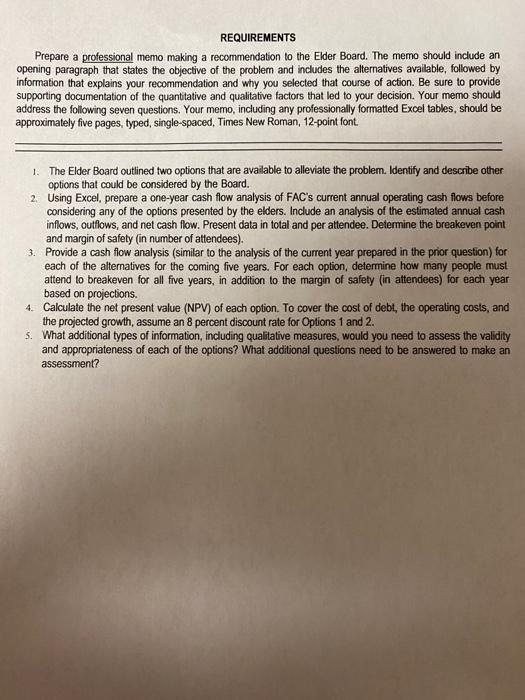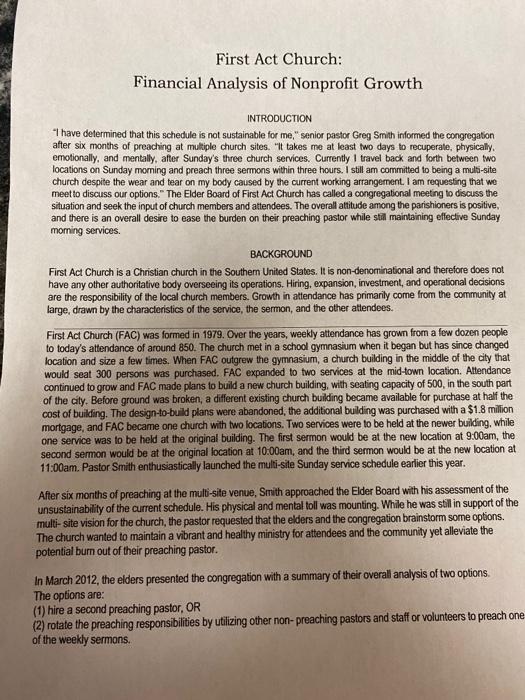Answered step by step
Verified Expert Solution
Question
1 Approved Answer
Since the images are not clear, I have reposted this Question as a new question in text only format. Thank you. Fist Church Pinancial Analysis



Since the images are not clear, I have reposted this Question as a new question in text only format.
Fist Church Pinancial Analysis of Nonprofit Growth mm WO . - - . w home. There MW wody telo - tem www Hip | . pate Wor REQUIREMENTS Prepare a professional memo making a recommendation to the Elder Board. The memo should include an opening paragraph that states the objective of the problem and includes the alternatives available, followed by information that explains your recommendation and why you selected that course of action. Be sure to provide supporting documentation of the quantitative and qualitative factors that led to your decision. Your memo should address the following seven questions. Your memo, including any professionally formatted Excel tables, should be approximately five pages, typed, single-spaced, Times New Roman, 12-point font. 1. The Elder Board outlined two options that are available to alleviate the problem. Identify and describe other options that could be considered by the Board. 2. Using Excel, prepare a one-year cash flow analysis of FAC's current annual operating cash flows before considering any of the options presented by the elders. Include an analysis of the estimated annual cash inflows, outflows, and net cash flow. Present data in total and per attendee. Determine the breakeven point and margin of safety (in number of attendees). 3. Provide a cash flow analysis (similar to the analysis of the current year prepared in the prior question) for each of the alternatives for the coming five years. For each option, determine how many people must attend to breakeven for all five years, in addition to the margin of safety (in attendees) for each year based on projections. 4. Calculate the net present value (NPV) of each option. To cover the cost of debt, the operating costs, and the projected growth, assume an 8 percent discount rate for Options 1 and 2. 5. What additional types of information, including qualitative measures, would you need to assess the validity and appropriateness of each of the options? What additional questions need to be answered to make an assessment? First Act Church: Financial Analysis of Nonprofit Growth INTRODUCTION "I have determined that this schedule is not sustainable for me," senior pastor Greg Smith informed the congregation after six months of preaching at multiple church sites. "It takes me at least two days to recuperate, physically emotionally, and mentally, after Sunday's three church services. Currently I travel back and forth between two locations on Sunday morning and preach three sermons within three hours. I still am committed to being a muls-site church despite the wear and tear on my body caused by the current working arrangement. I am requesting that we meet to discuss our options. The Elder Board of First Act Church has called a congregational meeting to discuss the situation and seek the input of church members and attendees. The overall attitude among the parishioners is positive, and there is an overall desire to ease the burden on their preaching pastor while still maintaining effective Sunday morning services. BACKGROUND First Act Church is a Christian Church in the Southern United States. It is non-denominational and therefore does not have any other authoritative body overseeing its operations. Hiring, expansion, investment, and operational decisions are the responsibility of the local church members. Growth in attendance has primarily come from the community at large, drawn by the characteristics of the service, the sermon, and the other attendees. First Act Church (FAC) was formed in 1979. Over the years, weekly attendance has grown from a few dozen people to today's attendance of around 850. The church met in a school gymnasium when it began but has since changed location and size a few times. When FAC outgrew the gymnasium, a church building in the middle of the city that would seat 300 persons was purchased. FAC expanded to two services at the mid-town location. Attendance continued to grow and FAC made plans to build a new church building, with seating capacity of 500, in the south part of the city. Before ground was broken a different existing church building became available for purchase at half the cost of building. The design-to-build plans were abandoned, the additional building was purchased with a $1.8 million mortgage, and FAC became one church with two locations. Two services were to be held at the newer building, while one service was to be held at the original building. The first sermon would be at the new location at 9.00am, the second sermon would be at the original location at 10:00am, and the third sermon would be at the new location at 11:00am. Pastor Smith enthusiastically launched the multi-site Sunday service schedule earlier this year. After six months of preaching at the multi-site venue, Smith approached the Elder Board with his assessment of the unsustainability of the current schedule. His physical and mental toll was mounting. While he was still in support of the multi-site vision for the church, the pastor requested that the elders and the congregation brainstorm some options. The church wanted to maintain a vibrant and healthy ministry for attendees and the community yet alleviate the potential burn out of their preaching pastor. In March 2012, the elders presented the congregation with a summary of their overall analysis of two options The options are: (1) hire a second preaching pastor, OR (2) rotate the preaching responsibilities by utilizing other non-preaching pastors and staff or volunteers to preach one of the weekly sermons. Fist Church Pinancial Analysis of Nonprofit Growth mm WO . - - . w home. There MW wody telo - tem www Hip | . pate Wor REQUIREMENTS Prepare a professional memo making a recommendation to the Elder Board. The memo should include an opening paragraph that states the objective of the problem and includes the alternatives available, followed by information that explains your recommendation and why you selected that course of action. Be sure to provide supporting documentation of the quantitative and qualitative factors that led to your decision. Your memo should address the following seven questions. Your memo, including any professionally formatted Excel tables, should be approximately five pages, typed, single-spaced, Times New Roman, 12-point font. 1. The Elder Board outlined two options that are available to alleviate the problem. Identify and describe other options that could be considered by the Board. 2. Using Excel, prepare a one-year cash flow analysis of FAC's current annual operating cash flows before considering any of the options presented by the elders. Include an analysis of the estimated annual cash inflows, outflows, and net cash flow. Present data in total and per attendee. Determine the breakeven point and margin of safety (in number of attendees). 3. Provide a cash flow analysis (similar to the analysis of the current year prepared in the prior question) for each of the alternatives for the coming five years. For each option, determine how many people must attend to breakeven for all five years, in addition to the margin of safety (in attendees) for each year based on projections. 4. Calculate the net present value (NPV) of each option. To cover the cost of debt, the operating costs, and the projected growth, assume an 8 percent discount rate for Options 1 and 2. 5. What additional types of information, including qualitative measures, would you need to assess the validity and appropriateness of each of the options? What additional questions need to be answered to make an assessment? First Act Church: Financial Analysis of Nonprofit Growth INTRODUCTION "I have determined that this schedule is not sustainable for me," senior pastor Greg Smith informed the congregation after six months of preaching at multiple church sites. "It takes me at least two days to recuperate, physically emotionally, and mentally, after Sunday's three church services. Currently I travel back and forth between two locations on Sunday morning and preach three sermons within three hours. I still am committed to being a muls-site church despite the wear and tear on my body caused by the current working arrangement. I am requesting that we meet to discuss our options. The Elder Board of First Act Church has called a congregational meeting to discuss the situation and seek the input of church members and attendees. The overall attitude among the parishioners is positive, and there is an overall desire to ease the burden on their preaching pastor while still maintaining effective Sunday morning services. BACKGROUND First Act Church is a Christian Church in the Southern United States. It is non-denominational and therefore does not have any other authoritative body overseeing its operations. Hiring, expansion, investment, and operational decisions are the responsibility of the local church members. Growth in attendance has primarily come from the community at large, drawn by the characteristics of the service, the sermon, and the other attendees. First Act Church (FAC) was formed in 1979. Over the years, weekly attendance has grown from a few dozen people to today's attendance of around 850. The church met in a school gymnasium when it began but has since changed location and size a few times. When FAC outgrew the gymnasium, a church building in the middle of the city that would seat 300 persons was purchased. FAC expanded to two services at the mid-town location. Attendance continued to grow and FAC made plans to build a new church building, with seating capacity of 500, in the south part of the city. Before ground was broken a different existing church building became available for purchase at half the cost of building. The design-to-build plans were abandoned, the additional building was purchased with a $1.8 million mortgage, and FAC became one church with two locations. Two services were to be held at the newer building, while one service was to be held at the original building. The first sermon would be at the new location at 9.00am, the second sermon would be at the original location at 10:00am, and the third sermon would be at the new location at 11:00am. Pastor Smith enthusiastically launched the multi-site Sunday service schedule earlier this year. After six months of preaching at the multi-site venue, Smith approached the Elder Board with his assessment of the unsustainability of the current schedule. His physical and mental toll was mounting. While he was still in support of the multi-site vision for the church, the pastor requested that the elders and the congregation brainstorm some options. The church wanted to maintain a vibrant and healthy ministry for attendees and the community yet alleviate the potential burn out of their preaching pastor. In March 2012, the elders presented the congregation with a summary of their overall analysis of two options The options are: (1) hire a second preaching pastor, OR (2) rotate the preaching responsibilities by utilizing other non-preaching pastors and staff or volunteers to preach one of the weekly sermons Thank you.
Step by Step Solution
There are 3 Steps involved in it
Step: 1

Get Instant Access to Expert-Tailored Solutions
See step-by-step solutions with expert insights and AI powered tools for academic success
Step: 2

Step: 3

Ace Your Homework with AI
Get the answers you need in no time with our AI-driven, step-by-step assistance
Get Started


